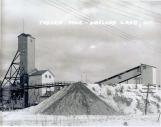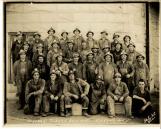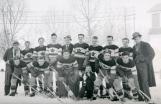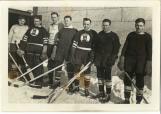1
The Temiskaming and Northern Ontario Railway (T&NO) was originally constructed in the early 1900's to open up Northern Ontario to further development, for both the lumber industry and creating access to farmland, while attempting to attract people to move to the area.An unexpected consequence of the railway was the discovery of large mineral deposits and the development of hard rock mining in the region - silver was discovered near the future site of the town of Cobalt, and gold was later discovered in the Kirkland Lake area.
With the potential of wealth and opportunities to work in the new mines, men moved to the North by the thousands.
The area surrounding Kirkland Lake was staked by 1912, and soon a town of the same name was established near its shores.
2
The history of Kirkland Lake is based as much on geography as it is geology.Like much of Northern Ontario, the land is a combination of forests, swamps, and rocky ground, with many freshwater lakes. This type of environment was largely inaccessible, except by boat, until the early 1900s.
The climate could be inhospitable as well. Winters could last for five months, with temperatures that reached -30°C for weeks at a time.
Despite these drawbacks, Northern Ontario was still able to attract newcomers to the area, often luring those with a sense of adventure.
The Claybelt regions of the Cochrane and Temiskaming districts offered rich farmland to those willing to make the move. The land that needed to be cleared for the farmland provided lumber and industry, and businesses grew in the new towns built to accommodate the needs of the farmers, workers and families that followed.
3
View of Early Toburn Property and LandscapeCirca 1913
Toburn Gold Mine, Kirkland Lake, Ontario, Canada
 Credits:
Credits:Images from Department of Mines Annual Reports
Image on loan from Gary Grabowski
4
With the discovery of gold in the Kirkland Lake area in the early 1910's, a frontier town atmosphere quickly developed with the arrival of thousands of people hoping to make their own fortune through prospecting.In the next image, the signage hanging above the wooden sidewalk indicates that Kirkland Lake is first and foremost a mining town, with geologists, engineers and assayers lining the street. In the foreground men can be seen socializing at the entrance of the general store. Items for purchase would include anything from supplies for prospectors, to household utensils and dry goods. Accommodation for newcomers to town often consisted of room and board and later bunkhouses at the established mines.
Mining towns can quickly go from boom to bust, but gold-rich Kirkland Lake continued to attract miners, workers, and their families. With so many people choosing to put down roots in Kirkland Lake, by the 1930's the town had gone from a frontier town to a community.
5
Early Kirkland LakeCirca 1920
Government Road, Kirkland Lake, Ontario, Canada
 Credits:
Credits:Photograph donated by Ted Irvine
Hockey Heritage North Archives
6
The rise of hockey in mining towns was a natural result of men rushing to the North when the T&NO began regular Northern service in 1905. The Temiskaming Mining League was formed in the Cobalt area that same year. Mining executives quickly saw the wisdom of not only funding enclosed arenas, but also of enticing players from other towns and parts of Canada to play in their leagues. These ideas were not lost when the railway and mining prospects moved further northward over the next several years to areas like Kirkland Lake, where they developed their own Mine Leagues.7
Toburn Gold MineCirca 1930's
Toburn Gold Mine, Kirkland Lake, Ontario, Canada
 Credits:
Credits:Museum of Northern History
8
Toburn MinersCirca 1930's
Toburn Gold Mine, Kirkland Lake, Ontario, Canada
 Credits:
Credits:Museum of Northern History
9
Since the start of hockey in the north, social factors were ever-present. The sport of hockey was popular long before it reached Kirkland Lake - but Kirkland Lake did its part to help perfect the sport.During the long winters, people wanted entertainment in their spare time, and hockey was a passionate enough sport for everyone in town to get behind. The cold weather and a lack of organized sports in the very early years of Kirkland Lake provided a large number of players for hockey and crowds of spectators to watch the games.
Many outdoor rinks could be found in town, with town leagues forming to provide entertainment for the citizens who played, and those who watched - the competition could be as fierce as the weather.
Before helmets and visors - in a day when sweaters, not layers of protective gear, stood between a player and the puck - players in the Mining Leagues were churning out fast-paced and rough games to the delight of Northern fans.
10
Men from the Northern towns as well as from other parts of Canada welcomed the opportunity to play on mining teams, especially as jobs grew scarce in the 1930s. What's more, players on mining teams were treated quite well: they often received time off (with pay) to practice and play in tournaments, and were independent enough to switch teams if they felt their skills could be put to better use on another team.Transportation between towns could be difficult and tedious at times, so town league competition made it possible for local players to sharpen their skills.
The development of hockey players in Kirkland Lake began with the basics - namely facilities and competition. It wasn't until January 12th 1927 that Kirkland Lake had its first indoor arena, and artificial ice did not make its debut at the Kirkland Arena until 1937. Ice time in the arena would be difficult to come by for those not at the Juvenile or Senior levels of hockey. The majority of the players used outdoor rinks for practice and games. An outdoor ice surface would mean a shorter playing season if it was a mild winter. Because of the distance that separated towns and limited transportation in the form of trains and rough roads, teams in towns like Kirkland Lake found their competition against one another, and encouraging the rivalries between the teams in town, whether they were from a mine league or not.
Industrial and commercial leagues were used as a way of keeping players in the North and playing for local leagues. With rules relating to a players residence and their ability to be transferred in place, players (including the "imported" players) were encouraged to stay in one place. Players were expected to not just play hockey for their employer - if you were hired by a mine, you were also expected to work for the mine, either above or below ground. By working for the mine, a hockey player was able to maintain their amateur player status, and to remain in the leagues.
11
Harold's Hockey TeamCirca 1937
Kirkland Lake, Ontario, Canada
 Credits:
Credits:Donated by Diane Doyan
Hockey Heritage North Archives
12
Butorac's Grocery Hockey TeamCirca 1939
Kirkland Lake, Ontario, Canada
 Credits:
Credits:Hockey Heritage North Archives
13
Golden Gate Service Hockey Team PlayersCirca 1940
Kirkland Lake, Ontario, Canada
 Credits:
Credits:Hockey Heritage North Archives
14
Toburn Mine Hockey PlayersCirca 1930's
Toburn Gold Mine, Kirkland Lake, Ontario, Canada
 Credits:
Credits:Museum of Northern History